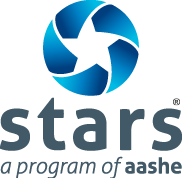| Overall Rating | Silver - expired |
|---|---|
| Overall Score | 51.05 |
| Liaison | Juliana Goodlaw-Morris |
| Submission Date | June 30, 2017 |
| Executive Letter | Download |
California State University, San Marcos
OP-5: Building Energy Consumption
| Status | Score | Responsible Party |
|---|---|---|

|
2.91 / 6.00 |
"---"
indicates that no data was submitted for this field
Figures needed to determine total building energy consumption:
| Performance Year | Baseline Year | |
| Grid-purchased electricity | 54,831 MMBtu | 53,165 MMBtu |
| Electricity from on-site renewables | 0 MMBtu | 0 MMBtu |
| District steam/hot water (sourced from offsite) | 0 MMBtu | 0 MMBtu |
| Energy from all other sources (e.g., natural gas, fuel oil, propane/LPG, district chilled water, coal/coke, biomass) | 0 MMBtu | 0 MMBtu |
| Total | 54,831 MMBtu | 53,165 MMBtu |
Start and end dates of the performance year and baseline year (or 3-year periods):
| Start Date | End Date | |
| Performance Year | Jan. 1, 2014 | Dec. 31, 2014 |
| Baseline Year | Jan. 1, 2014 | Dec. 31, 2014 |
A brief description of when and why the building energy consumption baseline was adopted (e.g. in sustainability plans and policies or in the context of other reporting obligations):
The baseline was chosen as this is a plateau period for building additions.
Gross floor area of building space:
| Performance Year | Baseline Year | |
| Gross floor area of building space | 1,284,448 Gross square feet | 1,263,548 Gross square feet |
Source-site ratio for grid-purchased electricity:
3.14
Total building energy consumption per unit of floor area:
| Performance Year | Baseline Year | |
| Site energy | 0.04 MMBtu per square foot | 0.04 MMBtu per square foot |
| Source energy | 0.13 MMBtu per square foot | 0.13 MMBtu per square foot |
Percentage reduction in total building energy consumption (source energy) per unit of floor area from baseline:
0
Degree days, performance year (base 65 °F / 18 °C):
| Degree days (see help icon above) | |
| Heating degree days | 1,790 Degree-Days (°F) |
| Cooling degree days | 1,913 Degree-Days (°F) |
Floor area of energy intensive space, performance year:
| Floor Area | |
| Laboratory space | 214,458 Square feet |
| Healthcare space | 20,000 Square feet |
| Other energy intensive space |
EUI-adjusted floor area, performance year:
1,793,229
Gross square feet
Building energy consumption (site energy) per unit of EUI-adjusted floor area per degree day, performance year:
8.26
Btu / GSF / Degree-Day (°F)
Documentation (e.g. spreadsheet or utility records) to support the performance year energy consumption figures reported above:
---
A brief description of the institution's initiatives to shift individual attitudes and practices in regard to energy efficiency (e.g. outreach and education efforts):
Staff attempts to reach out through student clubs, staff meetings and individual education to explain the importance of each person’s role in reducing energy use. The use of marketing materials on bulletin boards and common spaces serves as a resource for the campus community to understand energy consumption practices.
A brief description of energy use standards and controls employed by the institution (e.g. building temperature standards, occupancy and vacancy sensors):
-Temperature comfort zones set to 68 degrees (winter) and 78 degrees (summer)
-All classrooms spaces and most offices are equipped with occupancy and/or vacancy sensors.
-Common spaces are on lighting control panels that can be dimmed or turned off in naturally lite areas or during curtailment events.
A brief description of Light Emitting Diode (LED) lighting and other energy-efficient lighting strategies employed by the institution:
LED fixtures are used to replace fixtures as needed. The campus has a full scale LED and control upgraded planned, both internally and externally.
A brief description of passive solar heating, geothermal systems, and related strategies employed by the institution:
Many of the buildings on campus have large windows, these are our only PSH.
A brief description of co-generation employed by the institution, e.g. combined heat and power (CHP):
A fuel cell became operational in December 2015 through PPA. Waste heat is used to preheat boiler water and power absorption chiller to supplement cooling. The campus pays for the electricity produces and natural gas to supply fuel cell.
A brief description of the institution's initiatives to replace energy-consuming appliances, equipment and systems with high efficiency alternatives (e.g. building re-commissioning or retrofit programs):
EnerNOC has deployed MBCx projects including two year monitoring service on all stateside buildings on campus (excluding USU). At this point in time, approximately 90 % of campus buildings have been retro commissioned.
The website URL where information about the programs or initiatives is available:
Additional documentation to support the submission:
---
Data source(s) and notes about the submission:
---
The information presented here is self-reported. While AASHE staff review portions of all STARS reports and institutions are welcome to seek additional forms of review, the data in STARS reports are not verified by AASHE. If you believe any of this information is erroneous or inconsistent with credit criteria, please review the process for inquiring about the information reported by an institution or simply email your inquiry to stars@aashe.org.
